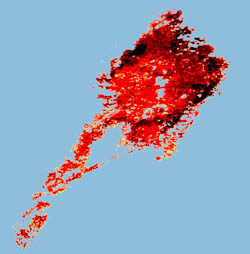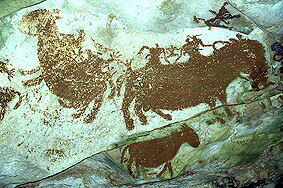|
A S I A Indonesia Muna Island, Southeast-Sulawesi |
planet. kite. matrix. |
muna island
liang kobori
(kobori or kabhori cave)
the early ancient cave-kiteman
a story about possible prehistoric
cavepaintings
showing a man flying a kite...
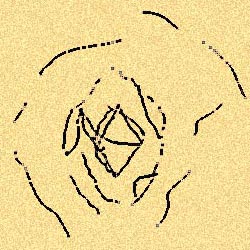 |
< drawing of the possible kite-picture by muna resident mr. LaSima ( taipei 2002) drawing by mr. Tinton from kuala lumpur, who visited kobori cave in 2002 > |
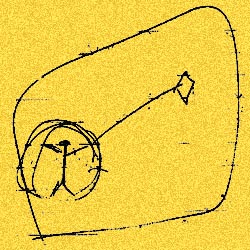
|
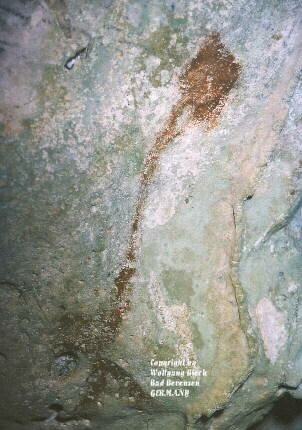 |
PHOTO ! visit wolfgang biecks new homepage with his story of the muna kitepainting - jan 2003
addition feb02, wolfgang bieck
says the name of the cave is NOT "kobhori" |
 |
beside a structural unsharp computer interpretation. height of the "cavekite-man"
drawing is about 30cm. |
|
march 2003, article
in drachenfoundation-journal, |
|
jan 2003. just received a message via wolfgang bieck: Robert
Bednarik, Convener, President and Editor, International Federation
of Rock Art Organisations (IFRAO) wrote: about rock art dating methods - |
|
"drachen foundation" journal fall 2002 - [ pdf file only ] Just How Old Is This Kite Cave Painting? With Indonesia dominated by Islam, further forays to Muna are for the time being obviously not in order for Westerners. So there the matter of the mystery kite image rests for the foreseeable future. |
|
here an article about muna cave-kite |
|
September 12, 2002, from an article in Jakarta Post "Kagathi kites or leaf kites from Muna, Southeast Sulawesi also produce a buzzing sound and can drive away monkeys, which would otherwise harm the rice fields... Sari .. will also announce to the international kite community
that in Southeast Sulawesi a cave with pictures of kites on its
walls has been discovered. The cave needs further study, but unfortunately
Indonesia has yet to find a kite researcher. |
|
The cave paintings in Indonesia have
been on the burner for some time. The ellipsoidal sail form in Indonesian and Malaysian
kites is so The toughest part has been to get an aware Western
observer into the caves |
|
|
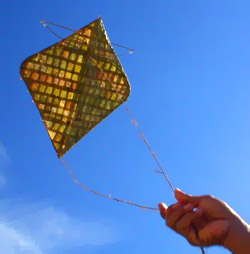 |
above, a computer drawing of the cavekite and a today "kagati" kite from muna
|
Last
up date: 2000/09/03
KITES & CULTURE; THE SPIRIT OF INDONESIA written by David Wagner and produced by The Drachen Foundation ... Because of this significance as the first form of man-made flight, the birthplace of the kite is still under scrutiny. It has been generally accepted that the kite was first invented in China long before the beginnings of written history. Recently, however, there has been sufficient evidence to suggest that it may have originated independently in the Malay Archipelago of Indonesia. There appears to be little written evidence from the earliest times, but by the fifteenth century, kites were so well established that contests were documented in the Malay Annals, an historical documentation of life in the islands. These kites featured a wing structure that appears to be unique in form and structure. It does not fit in the established pattern of evolution that marks all other kites with their origin on China. Perhaps it was influenced by the exceptionally graceful sails of the Indonesian fishing boats. This structure apparently migrated to Malaysia and became the basis for their exquisite wau kites, beginning with the wau merak of Johore province. Many kites in the Philippines seem to have developed from this shape as well. Evidence may yet be forthcoming. Cave painting recently discovered in Muna, Indonesia, may depict kite flying in great antiquity. Photographs and carbon dating are soon follow. [ asahi-net.or.jp ] |
|
The
Early Roots of Indonesian Art |
|
1996/11/01
rec.kites
newsgroup
During July 1996 I attended a kite festival at Kendari in Indonesia. Present at this festival were representatives of various local ethnic groups. One such group were the Muna, an indigenous people from an outlaying area of South East Sulawesi. The Muna had been brought to the Kendari festival through the efforts of Sari Madjid and a govener of S.E. Sulawesi for the purpose of introducint their traditions to the wider world of kite flying. Their kites were complex an sophisticated but used only natural materials. I noticed them initially because many of their techniques seemed not dissimilar to Maori kitemaking although scraped coconut frond fibre was used in place of scraped flax etc. I heard them using the word "Manu" and was very surprised when an interpreter defined it for me as their word for "kite" (or maybe a particular type of kite) because "Manu" is also the New Zealand Maori name for kite. As far as I am aware some ancestors of the New Zealand Maoris began the migration that eventually took them to New Zealand via Melanesia and Polynesia from this general area more than 5000 years ago. The obvious inferences from this are that the kites may have origins in Indonesia and may be much older than we think but we need to be very cautious about jumping to conclusions. There are many alternativce explanations ranging from my misunderstanding what was said or meant to coincidence to ---? But at least the possibility warrants further investigation via ethnology and luinguistics. Anyone looking for a thesis topic? Peter Lynn |
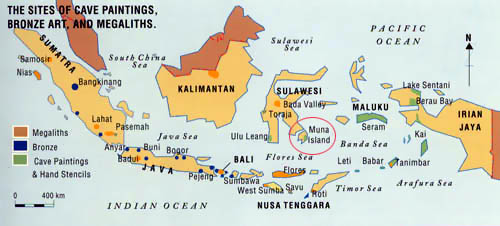
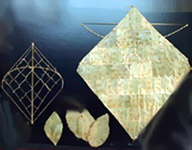
| Europe | Asia | MiddleEast | Afrika | America | Oceania |
planetkite.home
